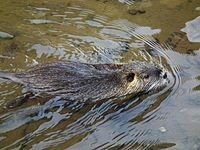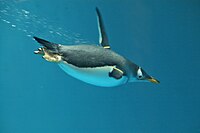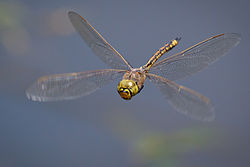Animal locomotion
Animal locomotion, in
Animals move for a variety of reasons, such as to find
The anatomical structures that animals use for movement, including cilia, legs, wings, arms, fins, or tails are sometimes referred to as locomotory organs[2] or locomotory structures.[3]
Etymology
The term "locomotion" is formed in English from Latin loco "from a place" (ablative of locus "place") + motio "motion, a moving".[4]
Locomotion in different media
Animals move through, or on, five types of environment: aquatic (in or on water), terrestrial (on ground or other surface, including arboreal, or tree-dwelling), fossorial (underground), and aerial (in the air). Many animals—for example semi-aquatic animals, and diving birds—regularly move through more than one type of medium. In some cases, the surface they move on facilitates their method of locomotion.
Aquatic
Swimming

In water, staying afloat is possible using buoyancy. If an animal's body is less dense than water, it can stay afloat. This requires little energy to maintain a vertical position, but requires more energy for locomotion in the horizontal plane compared to less buoyant animals. The drag encountered in water is much greater than in air. Morphology is therefore important for efficient locomotion, which is in most cases essential for basic functions such as catching prey. A fusiform, torpedo-like body form is seen in many aquatic animals,[5][6] though the mechanisms they use for locomotion are diverse.
The primary means by which
Other animals, such as
Dolphins sometimes ride on the bow waves created by boats or surf on naturally breaking waves.[10]
Benthic

Crabs typically walk sideways[13] (a behaviour that gives us the word crabwise). This is because of the articulation of the legs, which makes a sidelong gait more efficient.[14] However, some crabs walk forwards or backwards, including raninids,[15] Libinia emarginata[16] and Mictyris platycheles.[13] Some crabs, notably the Portunidae and Matutidae, are also capable of swimming,[17] the Portunidae especially so as their last pair of walking legs are flattened into swimming paddles.[18]
A stomatopod, Nannosquilla decemspinosa, can escape by rolling itself into a self-propelled wheel and somersault backwards at a speed of 72 rpm. They can travel more than 2 m using this unusual method of locomotion.[19]
Aquatic Surface

While larger animals such as ducks can move on water by floating, some small animals move across it without breaking through the surface. This surface locomotion takes advantage of the
Aerial
Active flight

Gravity is the primary obstacle to
Gliding
Rather than active flight, some (semi-) arboreal animals reduce their rate of falling by
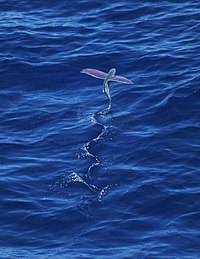
Some aquatic animals also regularly use gliding, for example, flying fish, octopus and squid. The flights of flying fish are typically around 50 meters (160 ft),[31] though they can use updrafts at the leading edge of waves to cover distances of up to 400 m (1,300 ft).[31][32] To glide upward out of the water, a flying fish moves its tail up to 70 times per second.[33] Several oceanic
Soaring
Soaring birds can maintain flight without wing flapping, using rising air currents. Many gliding birds are able to "lock" their extended wings by means of a specialized tendon.
Examples of soaring flight by birds are the use of:
- Thermals and convergences by raptors such as vultures
- Ridge lift by gulls near cliffs
- Wave lift by migrating birds[39]
- Dynamic effects near the surface of the sea by albatrosses
Ballooning
Terrestrial
Forms of locomotion on land include walking, running, hopping or
Jumping

Jumping (saltation) can be distinguished from running, galloping, and other gaits where the entire body is temporarily airborne by the relatively long duration of the aerial phase and high angle of initial launch. Many terrestrial animals use jumping (including hopping or leaping) to escape predators or catch prey—however, relatively few animals use this as a primary mode of locomotion. Those that do include the
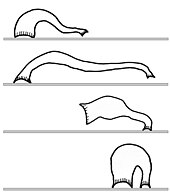
Peristalsis and looping
Other animals move in terrestrial habitats without the aid of legs. Earthworms crawl by a peristalsis, the same rhythmic contractions that propel food through the digestive tract.[48]
Leeches and geometer moth caterpillars move by looping or inching (measuring off a length with each movement), using their paired circular and longitudinal muscles (as for peristalsis) along with the ability to attach to a surface at both anterior and posterior ends. One end is attached, often the thicker end, and the other end, often thinner, is projected forward peristaltically until it touches down, as far as it can reach; then the first end is released, pulled forward, and reattached; and the cycle repeats. In the case of leeches, attachment is by a sucker at each end of the body.[49]
Sliding
Due to its low coefficient of friction, ice provides the opportunity for other modes of locomotion. Penguins either waddle on their feet or slide on their bellies across the snow, a movement called tobogganing, which conserves energy while moving quickly. Some pinnipeds perform a similar behaviour called sledding.
Climbing
Some animals are specialized for moving on non-horizontal surfaces. One common habitat for such
Others living on rock faces such as in
Some light animals are able to climb up smooth sheer surfaces or hang upside down by adhesion using suckers. Many insects can do this, though much larger animals such as geckos can also perform similar feats.
Walking and running
Species have different numbers of legs resulting in large differences in locomotion.
Modern birds, though classified as
There are no three-legged animals—though some macropods, such as kangaroos, that alternate between resting their weight on their muscular tails and their two hind legs could be looked at as an example of tripedal locomotion in animals.

Many familiar animals are quadrupedal, walking or running on four legs. A few birds use quadrupedal movement in some circumstances. For example, the shoebill sometimes uses its wings to right itself after lunging at prey.[52] The newly hatched hoatzin bird has claws on its thumb and first finger enabling it to dexterously climb tree branches until its wings are strong enough for sustained flight.[53] These claws are gone by the time the bird reaches adulthood.
A relatively few animals use five limbs for locomotion.
Insects generally walk with six legs—though some insects such as nymphalid butterflies[54] do not use the front legs for walking.
The scorpion Hadrurus arizonensis walks by using two groups of legs (left 1, right 2, Left 3, Right 4 and Right 1, Left 2, Right 3, Left 4) in a reciprocating fashion. This alternating tetrapod coordination is used over all walking speeds.[58]
Centipedes and millipedes have many sets of legs that move in
Many animals temporarily change the number of legs they use for locomotion in different circumstances. For example, many quadrupedal animals switch to bipedalism to reach low-level browse on trees. The genus of
-
Bipedal ostrich
-
Hexapedal stick-insect
-
Octopedal locomotion by a spider
-
Multi-legged millipede
Powered cartwheeling
The Moroccan flic-flac spider (
Subterranean
Some animals move through solids such as soil by burrowing using
.Arboreal locomotion

Arboreal locomotion is the locomotion of animals in trees. Some animals may only scale trees occasionally, while others are exclusively arboreal. These habitats pose numerous mechanical challenges to animals moving through them, leading to a variety of anatomical, behavioural and ecological consequences as well as variations throughout different species.
Brachiation (from brachium, Latin for "arm") is a form of arboreal locomotion in which primates swing from tree limb to tree limb using only their arms. During brachiation, the body is alternately supported under each forelimb. This is the primary means of locomotion for the small gibbons and siamangs of southeast Asia. Some New World monkeys such as spider monkeys and muriquis are "semibrachiators" and move through the trees with a combination of leaping and brachiation. Some New World species also practice suspensory behaviors by using their prehensile tail, which acts as a fifth grasping hand.[75]
Pandas are known to swig their heads laterally as they ascend vertical surfaces astonishingly utilizing their head as a propulsive limb in a anatomical way that was thought to only be practiced by certain species of birds.
Energetics
Animal locomotion requires
The most common metric of energy use during locomotion is the net (also termed "incremental") cost of transport, defined as the amount of energy (e.g.,
Energetics is important for explaining the evolution of foraging economic decisions in organisms; for example, a study of the African honey bee,
Passive locomotion
Passive locomotion in animals is a type of mobility in which the animal depends on their environment for transportation; such animals are vagile but not motile.[1]
Hydrozoans

The Portuguese man o' war (Physalia physalis) lives at the surface of the ocean. The gas-filled bladder, or pneumatophore (sometimes called a "sail"), remains at the surface, while the remainder is submerged. Because the Portuguese man o' war has no means of propulsion, it is moved by a combination of winds, currents, and tides. The sail is equipped with a siphon. In the event of a surface attack, the sail can be deflated, allowing the organism to briefly submerge.[79]
Mollusca
The
Arachnids
The
A spider (usually limited to individuals of a small species), or spiderling after hatching,
Insects
The
Members of the largest subfamily of cuckoo wasps,
Fleas can jump vertically up to 18 cm and horizontally up to 33 cm;[89] however, although this form of locomotion is initiated by the flea, it has little control of the jump—they always jump in the same direction, with very little variation in the trajectory between individual jumps.[90][91]
Crustaceans
Although
Animal transport
Some animals change location because they are attached to, or reside on, another animal or moving structure. This is arguably more accurately termed "animal transport".
Remoras
Remoras are a family (Echeneidae) of ray-finned fish.[93][94] They grow to 30–90 cm (0.98–2.95 ft) long, and their distinctive first dorsal fins take the form of a modified oval, sucker-like organ with slat-like structures that open and close to create suction and take a firm hold against the skin of larger marine animals.[95] By sliding backward, the remora can increase the suction, or it can release itself by swimming forward. Remoras sometimes attach to small boats. They swim well on their own, with a sinuous, or curved, motion. When the remora reaches about 3 cm (1.2 in), the disc is fully formed and the remora can then attach to other animals. The remora's lower jaw projects beyond the upper, and the animal lacks a swim bladder. Some remoras associate primarily with specific host species. They are commonly found attached to sharks, manta rays, whales, turtles, and dugongs. Smaller remoras also fasten onto fish such as tuna and swordfish, and some small remoras travel in the mouths or gills of large manta rays, ocean sunfish, swordfish, and sailfish. The remora benefits by using the host as transport and protection, and also feeds on materials dropped by the host.
Angler fish
In some species of anglerfish, when a male finds a female, he bites into her skin, and releases an enzyme that digests the skin of his mouth and her body, fusing the pair down to the blood-vessel level. The male becomes dependent on the female host for survival by receiving nutrients via their shared circulatory system, and provides sperm to the female in return. After fusing, males increase in volume and become much larger relative to free-living males of the species. They live and remain reproductively functional as long as the female lives, and can take part in multiple spawnings. This extreme sexual dimorphism ensures, when the female is ready to spawn, she has a mate immediately available. Multiple males can be incorporated into a single individual female with up to eight males in some species, though some taxa appear to have a one male per female rule.[96][97]
Parasites
Many
Changes between media
Some animals locomote between different media, e.g., from aquatic to aerial. This often requires different modes of locomotion in the different media and may require a distinct transitional locomotor behaviour.
There are a large number of semi-aquatic animals (animals that spend part of their life cycle in water, or generally have part of their anatomy underwater). These represent the major taxa of mammals (e.g., beaver, otter, polar bear), birds (e.g., penguins, ducks), reptiles (e.g., anaconda, bog turtle, marine iguana) and amphibians (e.g., salamanders, frogs, newts).
Fish
Some fish use multiple modes of locomotion.
Marine mammals

When swimming, several marine mammals such as dolphins, porpoises and pinnipeds, frequently leap above the water surface whilst maintaining horizontal locomotion. This is done for various reasons. When travelling, jumping can save dolphins and porpoises energy as there is less friction while in the air.
Some whales raise their (entire) body vertically out of the water in a behaviour known as "breaching".
Birds
Some semi-aquatic birds use terrestrial locomotion, surface swimming, underwater swimming and flying (e.g., ducks, swans).
Changes during the life-cycle
An animal's mode of locomotion may change considerably during its life-cycle.
Function
Animals locomote for a variety of reasons, such as to find food, a mate, a suitable microhabitat, or to escape predators.
Food procurement
Animals use locomotion in a wide variety of ways to procure food. Terrestrial methods include
Quantifying body and limb movement
The study of animal locomotion is a branch of biology that investigates and quantifies how animals move. It is an application of kinematics, used to understand how the movements of animal limbs relate to the motion of the whole animal, for instance when walking or flying.[108][109][110]
Galleries
-
Coypu(Rodentia)
-
Frog (Anura)
-
Sperm whales (Cetacea)
-
Gentoo penguin (Aves)
-
Marine iguana (Reptilia)
See also
- Animal migration
- Animal navigation
- Bird feet and legs
- Feather
- Joint
- Kinesis (biology)
- Microswimmer
- Movement of Animals (book)
- Role of skin in locomotion
- Sessile
- Taxis
References
- ^ a b "Animal locomotion". Encyclopædia Britannica. Retrieved December 16, 2014.
- ISBN 9780199142606.
- ISBN 9781489925138
- ^ "Locomotion". Online Etymology Dictionary. Retrieved December 16, 2014.
- ^ Gaston, K.A., Eft, J.A. and Lauer, T.E. (2016). "Morphology and its effect on habitat selection of stream fishes". Proceedings of the Indiana Academy of Science. 121 (1): 71–78.
{{cite journal}}: CS1 maint: multiple names: authors list (link) - PMID 9317308.
- PMID 11052539.
- S2CID 17226211. Archived from the original(PDF) on 2013-12-24.
- ^ Young, R.E.; Katharina M. Mangold, K.M. "Cephalopod jet propulsion". Tree of Life. Retrieved October 16, 2016.
- .
- S2CID 55933156. Archived from the original(PDF) on 2013-11-15.
- ^ Chenoweth, Stanley (1994). "The Green Sea Urchin in Maine, Fishery and Biology". State of Maine. Retrieved 4 October 2016.
- ^ S2CID 33455459.
- PMID 18089130.
- New South Wales Department of Primary Industries. 2005. Retrieved January 4, 2009.
- PMID 19166968.
- ^ Ng, P.K.L.; Guinot, D; Davie, P.J.F. (2008). "Systema Brachyurorum: Part I. An annotated checklist of extant Brachyuran crabs of the world" (PDF). Raffles Bulletin of Zoology. 17: 1–286. Archived from the original (PDF) on 2011-06-06.
- OCLC 794640315.
- ^ Srour, M. (July 13, 2011). "Mantis Shrimp (Crustacea: Stomatopoda)". Bioteaching.com. Archived from the original on December 29, 2019. Retrieved October 29, 2016.
- ISBN 978-0-691-08678-1.
- S2CID 32845070.
- ^ "How "Jesus Lizards" walk on water". National Geographic News. 2010. Archived from the original on January 27, 2006. Retrieved February 20, 2016.
- ^ ISBN 978-0-8053-7171-0.
- S2CID 84788761.
- PMID 788715.
- ^ Salleh, A. (November 7, 2014). "Insects evolved flight as plants grew taller". ABC. Retrieved October 14, 2016.
- ISSN 1612-4138.
- S2CID 4364892.
- ^ "Vertebrate flight: Chiropteran flight". Retrieved October 14, 2016.
- ^ "volplane", The Free Dictionary, retrieved 2022-01-06
- ^ Greenwood Press.
- ^ a b "Flying Fish | National Geographic". Animals. 2010-04-11. Archived from the original on February 28, 2021. Retrieved 2022-01-06.
- ^ a b c Kutschera, U. (2005). "Predator-driven macroevolution in flyingfishes inferred from behavioural studies: historical controversies and a hypothesis" (PDF). Annals of the History and Philosophy of Biology. 10: 59–77. Archived from the original (PDF) on 2007-08-20.
- S2CID 85088231.
- .
- ^ "Scientists Unravel Mystery of Flying Squid". National Geographic. 20 February 2013. Archived from the original on December 15, 2014. Retrieved 4 October 2016.
- ISBN 978-1-77007-151-3.
- ISBN 978-0-07-069633-4.
- ^ [Report of use of wave lift by birds by Netherlands Institute for Ecology][full citation needed]
- OCLC 54027960.
- ^ Valerio, C.E. (1977). "Population structure in the spider Achaearranea Tepidariorum (Aranae, Theridiidae)" (PDF). Journal of Arachnology. 3: 185–190. Archived from the original on July 19, 2011. Retrieved 2009-07-18.
{{cite journal}}: CS1 maint: bot: original URL status unknown (link) - ^ "Merriam's Kangaroo Rat Dipodomys merriami". U. S. Bureau of Land Management web site. Bureau of Land Management. Retrieved 2014-03-26.
- ^ Merlin, P. (2014). "Heteromyidae: Kangaroo Rats & Pocket Mice". Arizona-Sonora Desert Museum web site. Arizona-Sonora Desert Museum. Retrieved 2014-03-26.
- ^ Public Broadcasting System. 2014. Archived from the originalon 2014-03-26. Retrieved 2014-03-26.
- ^ JSTOR 1936601.
- ^ "Top 10 best jumper animals". Scienceray. Archived from the original on 2009-09-07. Retrieved 2012-06-11.
- S2CID 12643425.
- PMID 10952876.
- )
- PMID 7086349.
- S2CID 21030132.
- ^ Naish, Darren (2008-12-03). "B. rex! – Tetrapod Zoology". Scienceblogs.com. Retrieved 2014-06-10.
- .
- ^ "Butterflies in the Nymphalidae family". Retrieved 4 October 2016.
- ^ S2CID 40503319.
- S2CID 46935000.
- ISSN 1477-9145. Retrieved 2012-05-19.
- S2CID 26035077.
- ISSN 1178-9913.
- ISBN 978-0-03-030504-7.
- S2CID 21844282.
- ^ "Sea Star: Tube Feet & Locomotion". A Snail's Odyssey. Archived from the original on 2013-10-21.
- ^ "Leather star - Dermasterias imbricata". Sea Stars of the Pacific Northwest. Archived from the original on 2012-09-09. Retrieved 2012-09-27.
- ^ McDaniel, Daniel. "Sand star - Luidia foliolata". Sea Stars of the Pacific Northwest. Archived from the original on 2012-09-09. Retrieved 2012-09-26.
- ^ "Sunflower sea star". National Marine Fisheries Service. Retrieved December 27, 2014.
- ^ "How "Jesus Lizards" walk on water". National Geographic. 16 November 2004. Archived from the original on November 19, 2004. Retrieved December 22, 2014.
- ^ Sanders, R. (2012). "Stealth behavior allows cockroaches to seemingly vanish". UC Berkeley News Center. Retrieved December 22, 2014.
- ISBN 978-3-642-34681-1.
- ^ Bröhl, I.; Jördens, J. (April 28, 2014). "The Moroccan flic-flac spider: A gymnast among the arachnids". Senckenberg Gesellschaft für Naturforschung. Retrieved 23 May 2015.
- ^ Prostak, S. (May 6, 2014). "Cebrennus rechenbergi: Cartwheeling spider discovered in Morocco". Sci-News.com. Retrieved October 20, 2016.
- ^ Bhanoo, S. (May 4, 2014). "A desert spider with astonishing moves". The New York Times. The New York Times. Retrieved October 20, 2016.
- PMID 9600869.
- ^ Cartmill, M. (1985). "Climbing". In M. Hildebrand; D.M. Bramble; K.F. Liem; D.B. Wake (eds.). Functional Vertebrate Morphology. Belknap Press, Cambridge. pp. 73–88.
- PMID 19640883.
- ISBN 9780495509394.
- ^ ISBN 978-0198500223.
- PMID 15472015.
- PMID 23902913.
- ^ "Portuguese Man-of-War". National Geographic Society. Archived from the original on November 10, 2007. Retrieved December 16, 2014.
- PMID 21996498.
- PMID 33729256.
- ^ "The Desert is alive". Living Desert Adventures. 2008. Archived from the original on May 16, 2017. Retrieved December 16, 2014.
- ^ Armstrong, S. (14 July 1990). "Fog, wind and heat - life in the Namib desert". New Scientist (1725). Retrieved 2008-10-11.
- ^ Mark Gardiner, ed. (April 2005). "Feature creature". Gobabeb Times. p. 3. Archived from the original (PDF) on 2012-02-20.
- hdl:10919/29114. Archived(PDF) from the original on June 8, 2011. Retrieved September 26, 2020.
- ^ Weyman, G.S. (1995). "Laboratory studies of the factors stimulating ballooning behavior by Linyphiid spiders (Araneae, Linyphiidae)" (PDF). The Journal of Arachnology. 23: 75–84. Retrieved 2009-07-18.
- arXiv:1309.4731 [physics.bio-ph].
- PMID 21448275.
- ^ Crosby, J.T. "What is the life cycle of the flea". Archived from the original on September 19, 2005. Retrieved August 6, 2012.
- ^ "Insect jumping: An ancient question". Human Frontier Science Program. Archived from the original on December 16, 2014. Retrieved December 15, 2014.
- S2CID 14966793.
- S2CID 4311328.
- ^ Froese, Rainer, and Daniel Pauly, eds. (2013). "Echeneidae" in FishBase. April 2013 version.
- ^ "Echeneidae". Integrated Taxonomic Information System. Retrieved 20 March 2006.
- ^ "Sharksucker fish's strange disc explained". Natural History Museum. 28 January 2013. Archived from the original on 1 February 2013. Retrieved 5 February 2013.
- S2CID 4226567.
- ISBN 978-0-393-01716-8.
- ISBN 978-0-549-46429-7.
- ^ Fish, F. (1991). "On a fin and a prayer" (PDF). Scholars. 3 (1): 4–7. Archived from the original (PDF) on 2013-11-02.
- ^ Joseph Banks (1997). The Endeavour Journal of Sir Joseph Banks 1768–1771 (PDF). University of Sydney Library. Retrieved July 16, 2009.
- ^ PMID 21680390.
- ^ Binns, C. (2006). "How dolphins spin, and why". LiveScience. Retrieved December 20, 2014.
- ^ "Anti-predatory strategies of Cape fur seals at Seal Island". ReefQuest Centre for Shark Research. Retrieved December 20, 2014.
- ISBN 978-0-7876-5784-0.
- ^ Desert USA (1996). "Ostrich". Digital West Media. Retrieved 17 February 2011.
- ^ Stewart, D. (2006-08-01). "A Bird Like No Other". National Wildlife. National Wildlife Federation. Archived from the original on 2012-02-09. Retrieved 2014-05-30.
- ^ Holladay, April (23 April 2007). "Ostriches swim!". USA Today.
- PMID 30795901.
- PMID 31250807.
- PMID 20435815.
Further reading
- ISBN 0-691-08678-8
External links
![]() Media related to Animal locomotion at Wikimedia Commons
Media related to Animal locomotion at Wikimedia Commons

